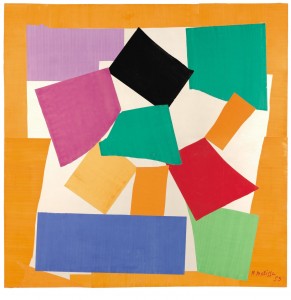
30 Jun 2014
One of the best things about being a Londoner is that you’re never more than a stone’s throw away from some of the world’s greatest art. Titian’s Bacchus and Ariadne at The National; Manet’s A Bar at the Folies Bergere at The Courtauld; or Matisse’s Snail at Tate Modern are all a Tube ride away. As a history of art student I spent many hours sitting in cool, quiet galleries studying the brushstrokes of some or other artist.
But what I hated then and what I hate now is some of the absolute bollocks that’s written about art. Those little bits of info that sit next to the work? I want it to tell me who the piece is by, when it was done and what materials were used. Then I want the juicy stuff. The fact that Wheat Field with Crows was Van Gogh’s last painting before he topped himself. Or that Jasper Johns and Robert Rauschenberg were actually lovers in the 1950s. (Last year’s MOMA exhibition in New York featuring the two artists described them as being ‘in dialogue’. What?) Or how Frida Kahlo’s health and tempestuous marriage to Diego Rivera affected her art. Or how the Pre-Raphaelite artist Rosetti painted Janey Morris time and time again because they were actually having a fling even though she was married to fellow artist William Morris at the time. Shock! Gasp!
I want to know what the artist was feeling or doing. Or who they were bonking or who or what they were influenced by. What I want is context. How did this piece of work come about?
What we get is a load of complex arty mumbo jumbo that stops us mere mortals understanding the work on a deeper level. Sculptor Grayson Perry in his Reith lectures last year quoted an editor of an art magazine who said her predecessor didn’t have English as a first language and so the magazine ‘suffered from the wrong kind of unreadability’. Good grief.
So I was amused to stumble across Phillip Hook’s Breakfast at Sotheby’s: an A-Z of the Art World recently. It’s a light-hearted glossary that sets out to deconstruct explain what certain art world words really mean. Here are a few of my favourites:
Accessible: Obvious/superficial
Challenging: Obscure, incomprehensible, unpleasant
Chromatism: Grand word for colouring
Gem/Jewel: Small painting
Gnosis: Pretentious word for knowledge of something
Honest: Inept
Journey: Career. Artists no longer have careers; they go on a journey
Mature: Debilitated by old age
Monumental: Large painting
Praxis: Pretentions synonym for practice ‘emblematic of the artist’s painterly praxis’ (translation: a typical work)
Primitive: Before 1890: inept. After 1890: powerful
Simulacrum: Grand word for imitation or replica
Space: A gallery
Subvert: Useful word to cover illogicality or inconsistency
Synthesis: More than one thing combined
Thematisation: Choice of subject matter
Trajectory: Career
Zeitgeist: An artist of their time. Those that go against fashion are referred to as ‘anaesthetising the zeitgeist.’
Breakfast at Sotheby’s: An A-Z of the Art World by Phillip Hook is available from Amazon.
Just for the record, I once wrote an essay about Palladio (Venetian architect 1508-1580) that my tutor described as being written in the style of the Sun newspaper. It was one of my proudest moments. (And yes, I still managed a 2:1.)








Laini
Posted at 11:10h, 01 JulyYep – this is what turns people off art RT @TurnerInk: On the blog: The fine art of talking cobblers http://t.co/h56tn4ODri
Paula Gale
Posted at 16:01h, 24 Octoberlove this – really amusing to someone who has literally just happened upon your blog… I was so interested, I came to the home page and found this blogpost… I have always thought that art critics talk a load of bollocks; they don’t allow the average person to really learn anything regular about a painting, piece of art, sculpture. Like you, it would be interesting to know where the idea of the painting came from – did the painting turn out the same as a vision or did it start out as one thing or turn into another (like everything I seem to touch). What were they thinking as the started the piece, were they in a happy mood, depressed – what really influenced the piece to turn out like it did; what really influenced them to pick up the brush and paint. Did they just spew lots of stuff out or was each piece a considered piece. There is a particular art critic that used to have a TV program… it was very ‘turn offable’. He made me not interested because they just go to deep and make assumptions – I prefer fact. I feel a little bit the same about poetry and prose, even short stories… Sometimes people just go over the top! I’m not a write nor a painter; not even a critic, but your post interested and entertained me and so I just had to comment (if you don’t mind that the comment could have been my very own blog post as it were!).
Smiley face from Paula x
Paula Gale
Posted at 16:05h, 24 Octoberoops, I put a ‘to’ word instead of ‘too’ somewhere in my comment… please forgive me – it was an oversight! lol but I couldn’t BEAR to leave it and have anyone think I was ignorant or illiterate. I hate it when I make such faux pas’… there should be an edit button for people like me who read after they’ve pressed ‘post it’. grrrr! 🙂
Paula x
Mike the Copywriter
Posted at 11:33h, 25 NovemberIt’s funny looking back to when some of these words came into my life – around the same time as discovering how deep and ‘enlightened’ my mates and I were, the word ‘juxtaposed’ appeared from nowhere. After about a week of using it to describe everything that was beside anything else, we dismissed it as ‘pretentious’. Pretentious stuck around a lot longer – being really handy for describing anything we didn’t like or understand. Good to see it still applies.